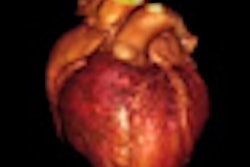MONTREAL - As MRI becomes faster and provides more detailed images, the modality will increase its value for diagnosing acute coronary syndrome and sources of chest pain in emergency departments (EDs), according to speakers at Tuesday's session of the International Society for Magnetic Resonance in Medicine (ISMRM) annual meeting.
Emergency departments in the U.S. handle more than 123 million visits each year, according to the U.S. Centers for Disease Control and Prevention, with more than 6 million would-be patients coming to emergency rooms complaining of chest pain.
Acute coronary syndrome is more than just a health concern, it's also an economic issue. Missed diagnoses of acute coronary syndrome are the most common cause for malpractice suits involving emergency departments in the U.S.
How difficult is a diagnosis of acute coronary syndrome? Dr. Andrew Arai, senior investigator at the National Heart, Lung, and Blood Institute, cited a study by the University of Pennsylvania of some 4,000 electrocardiograms (ECGs) that were used to diagnose acute coronary syndrome or chest pain at its emergency room. An ECG is the first test of choice because it can aid in a diagnosis in less than five minutes, even before a physician sees the patient or an ambulance arrives at the hospital with the patient.
Most importantly, the study found that while many high-risk patients presented with ischemia and acute myocardial infarction, just as many -- if not more -- seemingly low-risk patients experienced severe cardiac events.
"It is data like this that drives the emergency room physician nuts," Arai said. "If I learned one thing from my experience in the emergency room, it's that the emergency room physician is up against a tough diagnostic dilemma."
And the dilemma doesn't end there. Traditional clinical factors such as family history, diabetes, hypertension, and prior diagnosis of coronary artery disease that can contribute to a diagnosis of acute coronary syndrome also have a "remarkably poor chance of predicting the outcome for a patient," he added. Therefore, emergency room physicians need more reliable methods to diagnose cardiac patients more definitively.
With MRI, physicians are able to see a "physiologic metric of the consequences of coronary disease," Arai said. Cine images of the heart can detect ischemia, the thickness of wall motion, and how, for example, the paralysis of one wall may force the other side of the heart wall to work harder to compensate for the lack of motion.
One study by Arai and colleagues, published in Circulation, found that MRI's sensitivity in cases of acute myocardial infarction was 100% among the 151 consecutive patients. When evaluating for acute coronary syndrome, which includes acute myocardial infarction and unstable angina, MRI achieved a sensitivity of 84% and specificity of 85%. By comparison, sensitivity with an ECG was only 16%.
Arai also noted benefits of MRI as indicated in a 2008 study from Massachusetts General Hospital in Boston, also published in Circulation. Researchers developed a new cardiac MRI protocol by adding T2-weighted MRI to cine imaging and delayed contrast-enhanced MRI to assess left ventricular wall thickness. Among 62 patients in the study, the mean cardiac MR imaging time was 32 minutes, ranging from 24 to 40 minutes.
By adding T2-weighted imaging, specificity improved from 84% to 96%, positive predictive value rose from 55% to 85%, and accuracy improved from 84% to 93%, compared with a conventional cardiac MRI protocol of cine imaging, perfusion, and delayed contrast-enhanced MRI.
The advance of image acceleration techniques and technologies such as dynamic and parallel imaging and array coils over the past 15 years have also enhanced cardiac MRI's efficacy in the emergency department.
Real-time cardiac MRI
In a second ISMRM presentation, Orlando Simonetti, PhD, research director of cardiac MRI and CT at Ohio State University, discussed recent technical innovations such as parallel imaging that have made cardiac MRI even faster, and that have improved the modality's ability to answer tough clinical questions.
"The standard methods of parallel imaging have advanced and become clinically available to the point where real-time imaging of the heart is commonplace," Simonetti said. "The real strength of MRI is in the aspects of functional imaging and tissue characterization and how important that is in the setting of acute coronary syndrome, where the question is: Is chest pain caused by myocardial ischemia?"
For example, a 1.5-tesla MRI scanner with a 32-channel phased-array coil can increase image acceleration and still provide adequate images to diagnose acute cardiac syndrome. At Ohio State, Simonetti and colleagues have developed an analysis-paced imaging filter, which balances scan time with signal-to-noise to achieve higher acceleration rates.
While high image acceleration may not be necessary to image a resting heart, Simonetti said that the technology becomes more valuable for stress imaging, with heart rates of as fast as 150 beats per minute.
He referred to researchers at New York University who are developing 3D cardiac MRI technology by applying the acceleration technique to all basic acquisition schemes. "Perfusion, cine, coronary MR angiography, and late gadolinium enhancement have been extended to 3D breath-hold acquisitions to try to condense the entire MR exam to a five-minute study," he said. "It will be interesting to see how this plays out as they go into patient testing."
While some challenges remain, Arai concluded that cardiac MR in the emergency department "is diagnostically accurate, is well-suited to patients with intermediate probability of coronary disease, and can reduce the cost of evaluation made on a timely basis."
"I believe the biggest hurdles to this application are logistical," he said. "This is a challenge to the MR community to expand into this important clinical arena."
| Arai currently has a research agreement with Siemens Healthcare and has had previous research pacts with GE Healthcare. Simonetti also has received funding from Siemens. |



.fFmgij6Hin.png?auto=compress%2Cformat&fit=crop&h=100&q=70&w=100)




.fFmgij6Hin.png?auto=compress%2Cformat&fit=crop&h=167&q=70&w=250)











